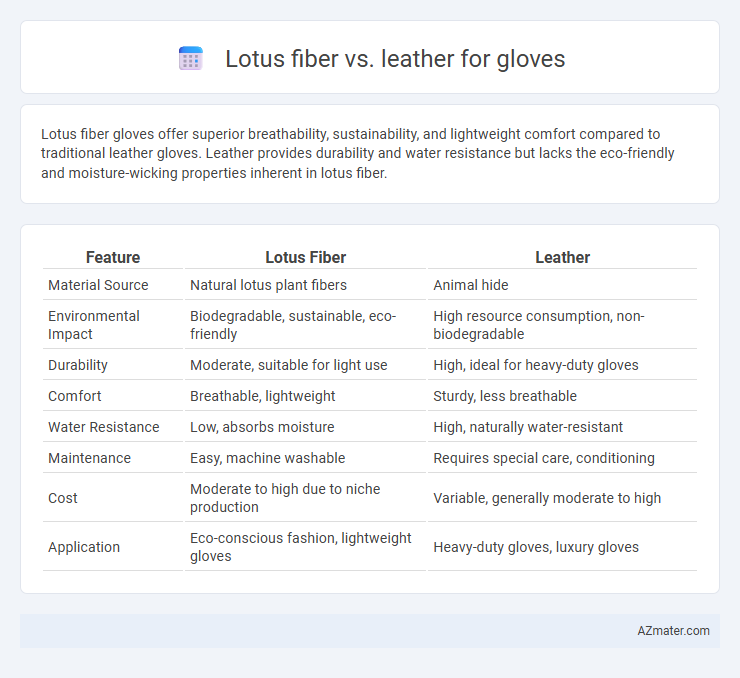Lotus fiber gloves offer superior breathability, sustainability, and lightweight comfort compared to traditional leather gloves. Leather provides durability and water resistance but lacks the eco-friendly and moisture-wicking properties inherent in lotus fiber.
Table of Comparison
| Feature | Lotus Fiber | Leather |
|---|---|---|
| Material Source | Natural lotus plant fibers | Animal hide |
| Environmental Impact | Biodegradable, sustainable, eco-friendly | High resource consumption, non-biodegradable |
| Durability | Moderate, suitable for light use | High, ideal for heavy-duty gloves |
| Comfort | Breathable, lightweight | Sturdy, less breathable |
| Water Resistance | Low, absorbs moisture | High, naturally water-resistant |
| Maintenance | Easy, machine washable | Requires special care, conditioning |
| Cost | Moderate to high due to niche production | Variable, generally moderate to high |
| Application | Eco-conscious fashion, lightweight gloves | Heavy-duty gloves, luxury gloves |
Introduction to Lotus Fiber and Leather Gloves
Lotus fiber gloves are crafted from the natural fibers extracted from lotus stems, offering exceptional breathability, eco-friendliness, and lightweight comfort. Leather gloves are made from animal hides, known for their durability, superior grip, and resistance to wear and tear. Comparing lotus fiber and leather gloves highlights the balance between sustainable materials and traditional strength in glove manufacturing.
Historical Context and Origins
Lotus fiber gloves originate from ancient Southeast Asian craftsmanship, where lotus stems were woven into fine, breathable textiles prized for ceremonial and practical use. In contrast, leather gloves trace back to prehistoric times, with evidence from ancient Egypt and Rome highlighting their role in protection and status symbolism. The evolution of lotus fiber emphasizes sustainable, plant-based materials, whereas leather reflects animal-derived durability and cultural heritage across civilizations.
Material Composition and Properties
Lotus fiber gloves are made from natural, biodegradable fibers extracted from lotus stems, offering breathability, lightweight texture, and antimicrobial properties ideal for sensitive skin. Leather gloves, derived from animal hides, provide durability, superior grip, and excellent abrasion resistance, making them suitable for heavy-duty and high-performance tasks. The choice between lotus fiber and leather hinges on prioritizing eco-friendly, hypoallergenic features versus long-lasting strength and protection.
Manufacturing Processes Compared
Lotus fiber gloves are produced through an eco-friendly process involving the careful extraction of fibers from lotus stems, which are then manually spun and woven, resulting in a lightweight and breathable material. Leather gloves require more resource-intensive manufacturing, including animal farming, tanning, and chemical treatments that enhance durability but increase environmental impact. The artisanal nature of lotus fiber production contrasts with the industrial mass production of leather gloves, offering a sustainable alternative with unique tactile qualities.
Durability and Longevity
Lotus fiber gloves offer remarkable durability due to their natural strength and resistance to wear, maintaining structural integrity even under frequent use. In contrast, leather gloves excel in toughness but require regular maintenance to prevent cracking and degradation over time. While leather provides excellent longevity with proper care, lotus fiber's eco-friendly composition enhances durability without sacrificing comfort or breathability.
Comfort and Wearability
Lotus fiber gloves offer superior breathability and moisture-wicking properties, enhancing overall comfort during extended wear. Leather gloves provide excellent durability and a snug fit but may cause sweating and reduced flexibility in hot or humid conditions. The natural lightweight texture of lotus fiber ensures better air circulation, making it ideal for comfort-sensitive applications.
Environmental Impact and Sustainability
Lotus fiber offers a biodegradable and renewable alternative to traditional leather, significantly reducing environmental pollution and dependency on animal agriculture, which is a major contributor to greenhouse gas emissions. Unlike leather production, which involves toxic chemical treatments and high water consumption, lotus fiber cultivation requires minimal resources and has a lower carbon footprint. Choosing lotus fiber gloves supports sustainable fashion practices by promoting eco-friendly materials that minimize waste and conserve natural ecosystems.
Cost Analysis and Market Availability
Lotus fiber gloves generally have higher production costs due to the labor-intensive extraction and limited scalability of lotus fibers compared to leather, which benefits from established mass-production techniques and a mature supply chain. Leather gloves remain more widely available in the global market, supported by extensive tanning industries and distribution networks, whereas lotus fiber gloves face niche market penetration with limited availability mostly in artisanal or eco-friendly segments. Price points for lotus fiber gloves tend to be premium, reflecting rarity and sustainability appeal, whereas leather gloves offer a broader range from budget to luxury options based on quality and treatment.
Ethical Considerations and Consumer Preferences
Lotus fiber gloves offer an eco-friendly alternative to traditional leather, appealing to consumers who prioritize sustainability and animal welfare. Ethical considerations highlight that lotus fiber is biodegradable and cruelty-free, whereas leather involves animal farming and environmental concerns. Consumer preferences increasingly favor lotus fiber for its unique texture and ethical production, aligning with the growing demand for vegan and sustainable fashion accessories.
Summary: Lotus Fiber vs Leather—Which Glove Wins?
Lotus fiber gloves offer exceptional breathability, sustainability, and natural antibacterial properties, making them ideal for eco-conscious users seeking comfort in warm conditions. Leather gloves provide superior durability, enhanced grip, and robust protection against abrasion, favored in heavy-duty or cold-weather environments. Choosing between lotus fiber and leather gloves depends on prioritizing eco-friendly comfort versus durability and protection.

Infographic: Lotus fiber vs Leather for Glove
 azmater.com
azmater.com